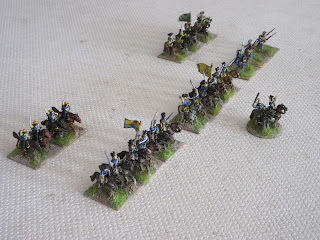This test brought the advance guards of Prussia and Austria in an accidental encounter. The Collision Course variant was used to deploy troops on to an 80cm x 80cm field. This proved too small for 3 battalions of infantry and 2 regiments of cavalry.
Austria won the first encounter, routing a Prussian battalion and mauling a second.
Test two was played on a wider field (120cm x 80cm) allowing the cavalry of both sides to work their magic. After four turns, cavalry formed up on the flanks to their infantry as they deployed from column to line.
A few turns further and both sides were ready for battle.
The Kálnoky Hussars opened the battle charging the Prussian Wechmar Hussars. The distance was further than expected allowing Wechmar to counter-charge the Austrians. Fortune however, favoured Austria sending the Prussians off table with Kálnoky in pursuit.
In centre, Austrian grenadiers moved in with the bayonet to savage the Winterfeldt Infantry sending them in flight. The Prussian attack against Austria’s left proving ineffective and the loss of two units routed, the general signalled the advance guard to retire from the field.
The pursuit off table continues.
A few notes.
Using the collision course variant, allow four to six turns for a solid deployment. Avoid the temptation of a quick attack as the unit may not have the support it needs.
The most common mistake is made as units deploy from column to line discovering a lack of space, more so if cavalry is part of column entering the table.
Shooting at
long distance may not be effective, but it can prove useful to pin part of the
enemy line while the main attack takes place elsewhere.
















